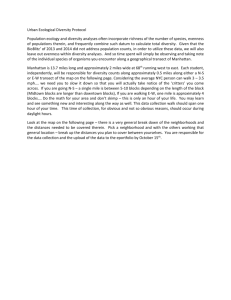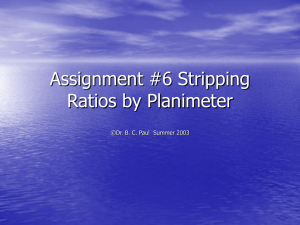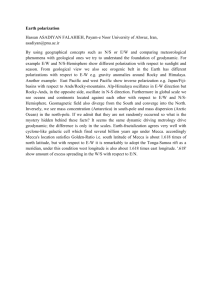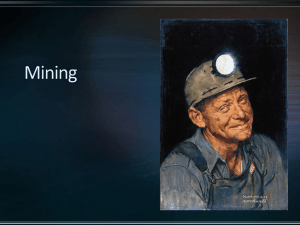The Variation in the Depth of Overburden at
advertisement
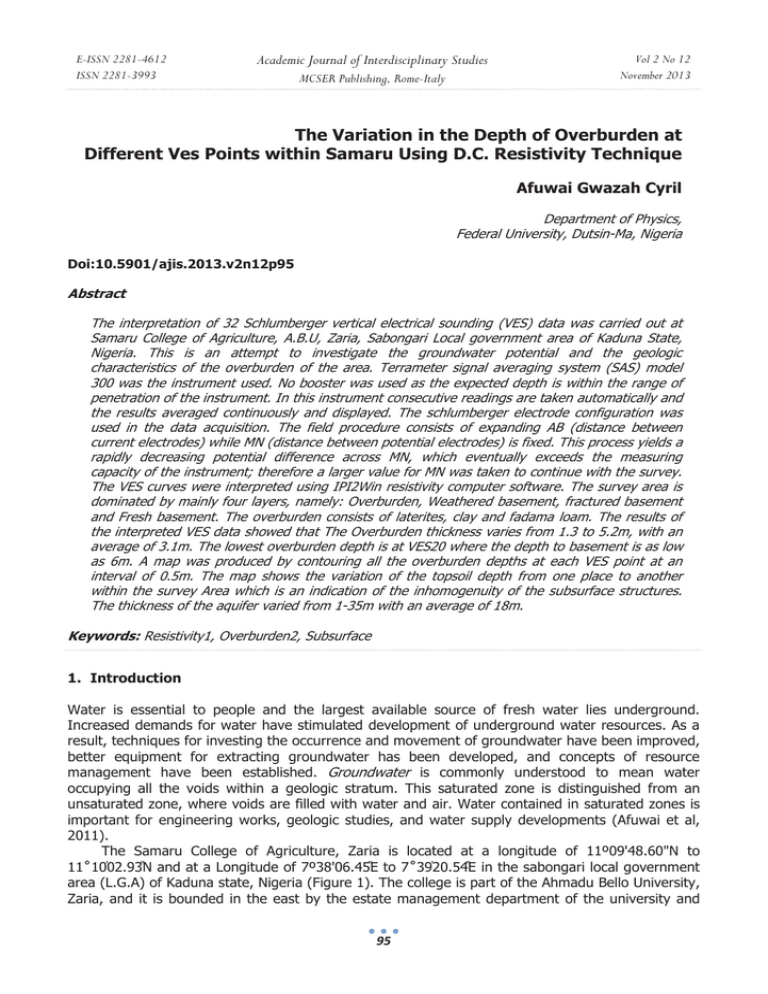
E-ISSN 2281-4612 ISSN 2281-3993 Academic Journal of Interdisciplinary Studies MCSER Publishing, Rome-Italy Vol 2 No 12 November 2013 The Variation in the Depth of Overburden at Different Ves Points within Samaru Using D.C. Resistivity Technique Afuwai Gwazah Cyril Department of Physics, Federal University, Dutsin-Ma, Nigeria Doi:10.5901/ajis.2013.v2n12p95 Abstract The interpretation of 32 Schlumberger vertical electrical sounding (VES) data was carried out at Samaru College of Agriculture, A.B.U, Zaria, Sabongari Local government area of Kaduna State, Nigeria. This is an attempt to investigate the groundwater potential and the geologic characteristics of the overburden of the area. Terrameter signal averaging system (SAS) model 300 was the instrument used. No booster was used as the expected depth is within the range of penetration of the instrument. In this instrument consecutive readings are taken automatically and the results averaged continuously and displayed. The schlumberger electrode configuration was used in the data acquisition. The field procedure consists of expanding AB (distance between current electrodes) while MN (distance between potential electrodes) is fixed. This process yields a rapidly decreasing potential difference across MN, which eventually exceeds the measuring capacity of the instrument; therefore a larger value for MN was taken to continue with the survey. The VES curves were interpreted using IPI2Win resistivity computer software. The survey area is dominated by mainly four layers, namely: Overburden, Weathered basement, fractured basement and Fresh basement. The overburden consists of laterites, clay and fadama loam. The results of the interpreted VES data showed that The Overburden thickness varies from 1.3 to 5.2m, with an average of 3.1m. The lowest overburden depth is at VES20 where the depth to basement is as low as 6m. A map was produced by contouring all the overburden depths at each VES point at an interval of 0.5m. The map shows the variation of the topsoil depth from one place to another within the survey Area which is an indication of the inhomogenuity of the subsurface structures. The thickness of the aquifer varied from 1-35m with an average of 18m. Keywords: Resistivity1, Overburden2, Subsurface 1. Introduction Water is essential to people and the largest available source of fresh water lies underground. Increased demands for water have stimulated development of underground water resources. As a result, techniques for investing the occurrence and movement of groundwater have been improved, better equipment for extracting groundwater has been developed, and concepts of resource management have been established. Groundwater is commonly understood to mean water occupying all the voids within a geologic stratum. This saturated zone is distinguished from an unsaturated zone, where voids are filled with water and air. Water contained in saturated zones is important for engineering works, geologic studies, and water supply developments (Afuwai et al, 2011). The Samaru College of Agriculture, Zaria is located at a longitude of 11º09'48.60"N to 11Û10ޤ02.93ޥN and at a Longitude of 7º38'06.45ޥE to 7Û39ޤ20.54ޥE in the sabongari local government area (L.G.A) of Kaduna state, Nigeria (Figure 1). The college is part of the Ahmadu Bello University, Zaria, and it is bounded in the east by the estate management department of the university and 95 E-ISSN 2281-4612 ISSN 2281-3993 Academic Journal of Interdisciplinary Studies MCSER Publishing, Rome-Italy Vol 2 No 12 November 2013 Institute of Agricultural research (I.A.R), and in the west by Area G Staff quarters. The study area has dry season (November to April) and wet season (May to October) with rain falling mainly during the wet season with an average annual rainfall of about 109cm (Hore, 1970). The college is accessible mainly through the Zaria-Shika main road. (Figure2). Figure 1. Map of Nigeria showing Zaria-Kaduna. Figure 2. Satellite image of the study Area. Source: Google Earth (2009). 2. Objectives This study aims at using ABEM Terrameter SAS 300 to carry out a geophysical survey to achieve the following Objectives: • Determination of the depth of Overburden at different VES Points. • To contour the Overburden depths at different VES Points within the survey Area. • To establish Areas within the Overburden that is suitable for waste disposal system. 3. Methodology In the DC resistivity surveying, an electric current is passed into the ground through two outer electrodes (A and B), and the resultant potential difference is measured across two inner electrodes (M and N) that are arranged in a straight line, symmetrically about a centre point Figure3. The ratio of the potential difference to the current is displayed by the Terrameter as resistance. A geometric factor in metres is calculated as a function of the electrode spacing. The electrode spacing is progressively increased, keeping the centre point of the electrode array fixed. 96 Academic Journal of Interdisciplinary Studies E-ISSN 2281-4612 ISSN 2281-3993 MCSER Publishing, Rome-Italy Vol 2 No 12 November 2013 Figure 3. Shows a schematic diagram of the schlumberger array used in the survey A and B are current electrodes through which current is supplied into the ground, M and N are two potential electrodes to measure the potential differences between the two electrodes and P is the VES station to be sounded. The potential difference between the two potential electrode is measured. The apparent resistivity is given by Ǐa = K (ƩV/I) with K a geometric factor which only depends on electrode spacing. The apparent resistivity is the ratio of the potential obtained in-situ with a specific array and a specific injected current by the potential which will be obtained with the same array and current for an homogeneous and isotropic medium of 1m resistivity. The apparent resistivity measurements give information about resistivity for a medium whose volume is proportional to the electrode spacing (Shemang, 1990). Resistivity is affected more by water content and quality than the actual rock material in porous formations. While aquifers that are composed of unconsolidated materials their resistivity decreases with the degree of saturation and salinity of the groundwater (Aboh, 2001). 4. Results and Discussion The data analysis for the VES was performed using IPI2Win’s new method for the automatic interpretation of schlumberger sounding curves. This method was used to obtain the model for the apparent resistivity of each sounding. The survey area is dominated by mainly four layers, namely: Overburden, Weathered basement, fractured basement and Fresh basement. The overburden consists of laterites, clay and fadama loam. The results of the interpreted VES data showed that The Overburden depths vary from 1.2 to 7.2m, with an average of 4.1m. The lowest overburden is at VES20 where the depth to basement is as low as 10m. A map was produced by contouring all the depths of the overburden layers at each VES point at an interval of 0.5m. The map shows the variation of the topsoil thickness from one place to another within the survey Area which is an indication of the inhomogenuity of the subsurface structures. The interpretation of all the VES points (01 to 32) is shown in table 2 below.Based on the IPI2Win’s method, the field curves were found to be averagely four (4) layers. Table1 shows the interpretation of VES POINT 01, and figure4 shows a typical digitized curve for VES POINT 01. The interpretation of all the VES points (01 to 32) is shown in Table2. Table1: Interpretation of Ves Point 11. Layer no. 1 2 3 4 Depth to basement at Ves Point 11 is 11.24m. Resistivity (ohm-m) Ǐ Thickness (m) h Depth (m) d 367.8 1.561 1.561 411.9 0.3184 1.879 143.9 9.365 11.24 672.9 - 97 E-ISSN 2281-4612 ISSN 2281-3993 Academic Journal of Interdisciplinary Studies MCSER Publishing, Rome-Italy Vol 2 No 12 November 2013 In figure4; Apparent resistivity (Ǐa) in ohm-metres is plotted against the electrode spacing (AB/2) in metres by the computer software IPI2Win on a log-log scale. The blue color gives the number of layers, the red color indicate the synthetic curve while the black color shows the curve for the field data. Figure 4. Shows a typical digitized curve for VES POINT 11. Table 2. Interpretation of VES Points 01 to 32. VES AZIMUTH Ǐ1 (ƻm) 01 NW-SE 367.8 02 NE-SW 258 03 N-S 283 04 E-W 290 05 N-S 130.6 06 N-S 97.9 07 E-W 333 08 E-W 55 09 E-W 58.4 10 N-S 116 11 E-W 148 12 E-W 136 13 E-W 219 14 E-W 86.2 15 E-W 207.2 16 E-W 50.4 17 E-W 151 18 E-W 98.2 19 E-W 105 20 E-W 97.9 21 E-W 163 22 E-W 148 23 N-S 90 24 N-S 28.4 25 N-S 362 26 N-S 208 27 N-S 357 28 N-S 293 29 N-S 266 30 E-W 124 31 E-W 221 32 N-S 324 h1 (m) Ǐ2 (ƻm) h2(m) Ǐ3(ƻm) 1.561 411.9 0.3184 143.9 1.48 137 2.65 62.1 0.566 186 2.13 49.1 1.27 578 2.88 1413 2.633 1713 2.856 516.5 0.6 139 1.62 1068 1.26 181 4.23 69.6 0.7 73.2 3.7 1273 1.13 76.3 3.62 679 0.915 292 0.457 101 0.409 754 0.368 69.3 0.6 313 0.654 69.2 0.342 8518 0.374 1059 0.37 2400 0.478 319 0.6 364.7 0.7719 693.1 0.385 1001 0.916 76.2 1.89 1957 1.67 392 2.6 258 6.92 674 5.54 300 1.67 486 2.62 133 8.88 432 0.45 89.1 4.99 316 2.36 165 1.07 444 2.47 208 5.67 462 0.343 197 0.454 38.5 0.684 88.5 3.96 773 3.79 82.2 10.6 37.1 0.241 179 1.63 33.5 4.87 79.4 17 189 0.789 204 5.53 44.7 0.505 367 0.651 123 0.364 153 6.66 1303 2.63 108 7.59 458 h3(m) Ǐ4(ƻm) h4(m) Ǐ5(ƻm) h5(m) 9.365 672.9 8.05 558 9.85 611 2.16 3821 5.97 738.9 4.86 1963 7.77 2009 2.99 114 4.5 141 1.77 568 13.3 316 18.3 10512 4.24 155 45 419 25.5 511 1.765 744.3 53.1 3779 74.5 447 14.5 720 80.6 527 8.42 373 21.2 1290 77.4 576 4.14 80.8 14.8 54.9 8.55 54 8.05 24.7 21.9 4751 64.7 1676 3.26 1063 - The Overburden depths map was produced by contouring all the depths of the first layer at each VES point at an interval of 0.5m. The map is shown in figure5. The map shows the variation of the Overburden thickness from one place to another within the survey area. The thickness varies from 98 E-ISSN 2281-4612 ISSN 2281-3993 Academic Journal of Interdisciplinary Studies MCSER Publishing, Rome-Italy Vol 2 No 12 November 2013 0.2 to 5.2m, with an average of 2.1m. The lowest thickness is at VES27 where the depth to basement is as low as 10m. The surface plot in Figure6 shows a clearer variation in the Overburden thicknesses within the Area. Figure5. Shows the contour map of the Overburden depths within the survey area. Figure 6. Shows the Surface plot of the Overburden depths. 5. Conclusion The survey area is dominated by mainly four layers, namely: Overburden, Weathered basement, fractured basement and Fresh basement. The overburden consists of laterites, clay and fadama loam. The results of the interpreted VES data showed that The Overburden depth varies from 1.2 to 7.2m, with an average of 4.1m. The lowest overburden thickness is at VES20 where the depth to basement is as low as 10m. A map was produced by contouring all the depths of the overburden layers at each VES point at an interval of 0.5m. The map shows the variation of the Overburden depth from one place to another within the survey Area, which is an indication of the inhomogenuity of the subsurface structures. VES Points where the thickness of the Overburden is large also have large Aquifer thickness and vice-versa. There is also correlation between the Overburden thickness and depth to basement; Areas where the Overburden thickness is low have low depth to basement, such areas are considered suitable for waste disposal system, owing to the fact that the groundwater potential in such areas are not sustainable. 99 E-ISSN 2281-4612 ISSN 2281-3993 Academic Journal of Interdisciplinary Studies MCSER Publishing, Rome-Italy Vol 2 No 12 November 2013 References Aboh, H.O. (2001). Detailed Regional Geophysical Investigation of the Subsurface Structures in Kaduna Area, Nigeria. Unpublished PhD Thesis, A.B.U, Zaria. Afuwai, G.C, Lawal, K.M, and Aminu, A.L (2011). Investigation of Groundwater Potential at Samaru College of Agriculture, Ahmadu Bello University, Zaria-Nigeria. Unpublished M.Sc Thesis. Ahmadu Bello University, Zaria-Nigeria. Hore, P.N. (1970). Weather and Climate: Zaria and its region. Ed. By M.J. Mortimore, Dept of Geography, Occasional Paper no. 4, A.B.U, Zaria, pp 41-54. Shemang, E.M. (1990). Electrical Depth Sounding at Selected Well sites within Kubani River Basin, Zaria. Unpublished M.Sc Thesis, A.B.U, Zaria. 100
